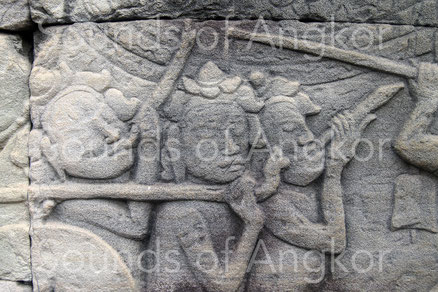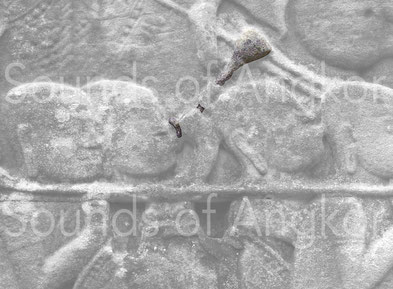Last update: December 5, 2023
Trumpets and horns (or olifant) are called “lip reed aerophones”. In the majority of cases, the quality of the sculpture does not allow either a precise organological identification or a formal determination of the material. This may be due to the structural simplicity of some of them: simple cow, buffalo or wild bovid horn whose tip has been cut and pierced with a glowing iron, bamboo... Some prestigious trunks were probably made from elephant tusks; world ethnography bears witness to this. However, there is one exception: the most beautiful trumpets can be seen on the Historical Parade bas relief in the third south gallery, west wing, of Angkor Wat. They appear to be metallic instruments because of their length, curvature, and the peculiar shape of their pavilions.
Like the conches, their basic functional organization is the pair (or couple?), which could be duplicated at will, as is still the case in contemporary India. This system of parity of trumpets and conches is found in Tibetan Buddhist orchestras.
Trumpets of the Historical Parade's bas-relief in Angkor Wat
In this scene of the Historical Parade, one sees two long and two short trumpets, one in profile and the other in front. The latter can only be distinguished from its mouthpiece and the upper end of the tube just behind the attachment point of the big drum. These long and short trumpets have a length ratio of one to two, which suggests that they sound theoretically at the octave. If we take 1.65 m as the mean size of characters, the total size of the large horns would be close to 1.30 m and 0.65 m for the short one.
The long trumpet at the extreme left and the small one view in profile show a conical mouthpiece.
For the long trumpets, the first section of the tube is straight and the bell is curved, shaped like a stylized makara mouth. On the tube extending from the mouth to the base of the bell, there are no connections, which is however the case on most large Asian trumpets, which can be disassembled or telescoped. This connection may be concealed by the left hand of the musicians.
On the small trumpet seen in profile appear two series of striations, one above the musician's hands, a second one at the base of the bell's flare.
Other trumpets in the south gallery of Angkor Wat
The other trumpets of the south gallery of Angkor Wat are less interesting. They are slightly curved with a small makara's mouth-shaped bell. It is difficult to say if they are trumpets or horns and to define the material.
Trumpets of the north gallery of Angkor Wat
Dual trumpets played alongside single-pipe instruments are also found in the north gallery of Angkor Wat. Are they two independent tubes blown simultaneously or joined together in a single mouth?
The iconography of the north gallery of Angkor Wat also reveals some rare C-shaped horns of poor quality in their design, perhaps made of buffalo horn or metal.
In India and Nepal exist until now C-shaped metal trumpets.
C-shaped trumpet. Angkor Wat. Krishna’s Victory over Asura Bāna, north gallery, east wing. 16th c.
Trumpets of Bayon
In Bayon, most of the trumpets representations are of poor quality. The mouthpieces are invisible.
A bas-relief of the Bayon shows an atypical trumpet compared to the overall corpus. One can see the mouthpiece and a conical-shaped bell.
Even more unusual is a trumpet with an enigmatic shape. It is made of a juxtaposition of spheres of increasing size that does not correspond to any model listed elsewhere. It could be made of bamboo, especially with the species Bambusa vulgaris Wamin. Ironically, it is by visiting the tomb of Jean Commaille, a few steps from the Bayon, whose access is bordered by this species of bamboo, that the solution was found! This bamboo is not naturally hollow. It is thus necessary to hollow it out to transform it into a trunk. There are two occurrences in the Bayon (east gallery, south wing).
Trumpets through epigraphy
The only term that designate the trumpets is tūrya (tūryya), both in Sanskrit and Old Khmer. This word was translated by the epigraphists as a "set of musical instruments" in the orchestral sense. This is particularly the case in G. Cœdès* for the foundation stele of Pre Rup (961 AD).
*Cœdès G. 1937 - IC I, p.103:CCLXXXIV.
Sanskrit text
suvarṇṇabhogī maṇirāśisāndras
samudravat tatparikalpito smin
velāvivṛddho stv anatītya deva-
pūjāvidhis tūryyaravormminādaḥ
Original French translation
Que dans lʼavenir le culte des dieux, fixé ici par lui, pourvu dʼor, plein dʼune quantité de joyaux, ayant pour bruit des vagues le son des instruments de musique, soit comme lʼocéan augmenté par le temps [ou : le flot].
Revised French translation
Que dans lʼavenir le culte des dieux, fixé ici par lui, pourvu dʼor, plein dʼune quantité de joyaux, ayant pour bruit des vagues le son des trompes, soit comme lʼocéan augmenté par le temps [ou : le flot].
English translation
That in the future the worship of the gods, fixed here by him, provided with gold, full of a number of jewels, having for sound of waves the sound of trumpets, or as the ocean increased by time (or: the flood).
The founding inscriptions of the Lolei temple (late 9th century) offer eight lists in which there are male players of tūrya (written turyya), five out of seven occurrences and four out of the eighth one. The inscription of Prasat Kravan temple (921 A.D.) quotes three players of tūrrya. What is striking in all these examples is the assimilation of the instrument name to that of the musicians. Indeed, for percussion and string instruments there is a specific terminology that describes the musician as "percussion instrument player" and "string instrument player" respectively. Now in the case of tūrya, instrument and musician become confused.
Manufacture of a olifant made of buffalo horn
There are two qualities of buffalo horns: light and heavy, all proportions kept. The first are preferred because only the tip of the horn is filled with material.
After cutting the tip of the horn, the manufacturer fires at least two to three irons to make the work more fluid. He opens the insufflation duct millimeter by millimeter. Then the mouthpiece is adapted to facilitate the insufflation without injuring the lips. The horn is then cleaned and polished with sandpaper. In the past, polishing was perhaps done with wild plant leaves, which are still known to forest populations today. A model was made by adding a copper border with a lotiform decoration.
Manufacture of a buffalo horn olifant with a copper frame.



























